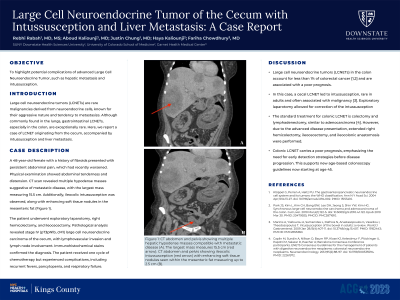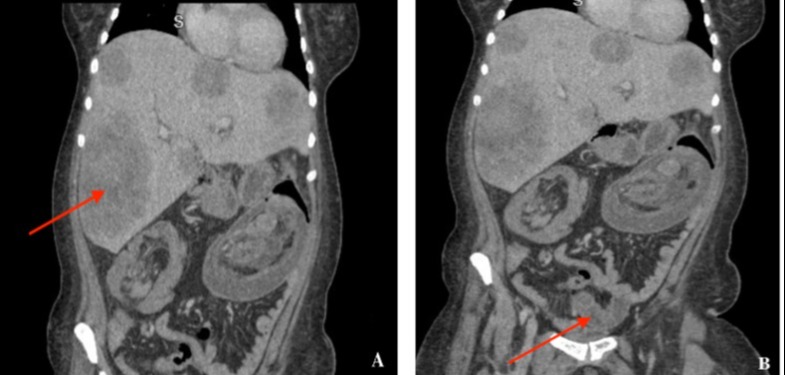Sunday Poster Session
Category: Colon
P0305 - Large Cell Neuroendocrine Tumor of the Cecum With Intussusception and Liver Metastasis: A Case Report
Sunday, October 22, 2023
3:30 PM - 7:00 PM PT
Location: Exhibit Hall

Has Audio
.jpg)
Rebhi Rabah, MD
SUNY Downstate Health Sciences University
Brooklyn, NY
Presenting Author(s)
Rebhi Rabah, MD1, Aboud Kaliounji, MD1, Justin Chung, MD1, Haya Kaliounji, BS2, Fariha Chowdhury, MD3
1SUNY Downstate Health Sciences University, Brooklyn, NY; 2University of Colorado Anschutz Medical Campus, Aurora, CO; 3Garnet Health Medical Center, Middletown, NY
Introduction: Large cell neuroendocrine tumors (LCNETs) are rare malignancies derived from neuroendocrine cells, known for their aggressive nature and tendency to metastasize. Although commonly found in the lungs, gastrointestinal LCNETs, especially in the colon, are exceptionally rare. Here, we report a case of LCNET originating from the cecum, accompanied by intussusception and liver metastasis.
Case Description/Methods: We present the case of a 48-year-old female with a history of fibroids who presented with persistent abdominal pain, which had recently worsened. Physical examination showed abdominal tenderness and distension. CT scan revealed multiple hypodense masses suggestive of metastatic disease, with the largest mass measuring 15.5 cm. Additionally, ileocolic intussusception was observed along with enhancing soft tissue nodules in the mesenteric fat (Figure 1). The patient underwent exploratory laparotomy, right hemicolectomy, and ileocecectomy. Pathological analysis revealed stage IV (pT3pN1b, cM1) large cell neuroendocrine carcinoma of the cecum, with lymphovascular invasion and lymph node involvement. Immunohistochemical stains confirmed the diagnosis. The patient received one cycle of chemotherapy but experienced complications, including recurrent fevers, pancytopenia, and respiratory failure. Currently, she remains in the intensive care unit with a poor prognosis.
Discussion: Large cell neuroendocrine tumors (LCNETs) in the colon are extremely rare and associated with a poor prognosis. Understanding the presentation and management of these tumors is crucial. In this case, a LCNET of the cecum accompanied by intussusception was observed. Intussusception is most common in pediatric patients, with adult cases accounting for 5% of all cases of intussusception. Within adult populations, malignancy can be a source of intussusception. In this case, the LCNET served as a lead point for intussusception. The current standard treatment for colonic LCNET is colectomy and lymphadenectomy, similar to adenocarcinoma. However, due to the advanced disease presentation, extended right hemicolectomy, ileocecectomy, and ileocolonic anastomosis were performed. Exploratory laparotomy allowed for correction of the intussusception. This case highlights the potential complications of advanced LCNET, such as intussusception, necessitating investigation of underlying symptoms. Colonic LCNET carries a poor prognosis, emphasizing the need for research into secondary prevention strategies before disease progression.

Disclosures:
Rebhi Rabah, MD1, Aboud Kaliounji, MD1, Justin Chung, MD1, Haya Kaliounji, BS2, Fariha Chowdhury, MD3. P0305 - Large Cell Neuroendocrine Tumor of the Cecum With Intussusception and Liver Metastasis: A Case Report, ACG 2023 Annual Scientific Meeting Abstracts. Vancouver, BC, Canada: American College of Gastroenterology.
1SUNY Downstate Health Sciences University, Brooklyn, NY; 2University of Colorado Anschutz Medical Campus, Aurora, CO; 3Garnet Health Medical Center, Middletown, NY
Introduction: Large cell neuroendocrine tumors (LCNETs) are rare malignancies derived from neuroendocrine cells, known for their aggressive nature and tendency to metastasize. Although commonly found in the lungs, gastrointestinal LCNETs, especially in the colon, are exceptionally rare. Here, we report a case of LCNET originating from the cecum, accompanied by intussusception and liver metastasis.
Case Description/Methods: We present the case of a 48-year-old female with a history of fibroids who presented with persistent abdominal pain, which had recently worsened. Physical examination showed abdominal tenderness and distension. CT scan revealed multiple hypodense masses suggestive of metastatic disease, with the largest mass measuring 15.5 cm. Additionally, ileocolic intussusception was observed along with enhancing soft tissue nodules in the mesenteric fat (Figure 1). The patient underwent exploratory laparotomy, right hemicolectomy, and ileocecectomy. Pathological analysis revealed stage IV (pT3pN1b, cM1) large cell neuroendocrine carcinoma of the cecum, with lymphovascular invasion and lymph node involvement. Immunohistochemical stains confirmed the diagnosis. The patient received one cycle of chemotherapy but experienced complications, including recurrent fevers, pancytopenia, and respiratory failure. Currently, she remains in the intensive care unit with a poor prognosis.
Discussion: Large cell neuroendocrine tumors (LCNETs) in the colon are extremely rare and associated with a poor prognosis. Understanding the presentation and management of these tumors is crucial. In this case, a LCNET of the cecum accompanied by intussusception was observed. Intussusception is most common in pediatric patients, with adult cases accounting for 5% of all cases of intussusception. Within adult populations, malignancy can be a source of intussusception. In this case, the LCNET served as a lead point for intussusception. The current standard treatment for colonic LCNET is colectomy and lymphadenectomy, similar to adenocarcinoma. However, due to the advanced disease presentation, extended right hemicolectomy, ileocecectomy, and ileocolonic anastomosis were performed. Exploratory laparotomy allowed for correction of the intussusception. This case highlights the potential complications of advanced LCNET, such as intussusception, necessitating investigation of underlying symptoms. Colonic LCNET carries a poor prognosis, emphasizing the need for research into secondary prevention strategies before disease progression.

Figure: Figure 1: A) CT abdomen and pelvis showing multiple hepatic hypodense masses compatible with metastatic disease. The largest mass measures 15.5 cm (red arrow). CT abdomen and pelvis showing ileocolic intussusception with enhancing soft tissue nodules seen within the mesenteric fat measuring up to 2.5 cm.
Disclosures:
Rebhi Rabah indicated no relevant financial relationships.
Aboud Kaliounji indicated no relevant financial relationships.
Justin Chung indicated no relevant financial relationships.
Haya Kaliounji indicated no relevant financial relationships.
Fariha Chowdhury indicated no relevant financial relationships.
Rebhi Rabah, MD1, Aboud Kaliounji, MD1, Justin Chung, MD1, Haya Kaliounji, BS2, Fariha Chowdhury, MD3. P0305 - Large Cell Neuroendocrine Tumor of the Cecum With Intussusception and Liver Metastasis: A Case Report, ACG 2023 Annual Scientific Meeting Abstracts. Vancouver, BC, Canada: American College of Gastroenterology.
